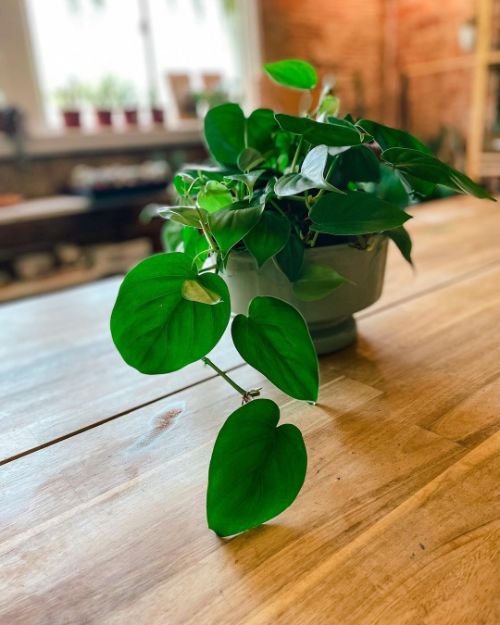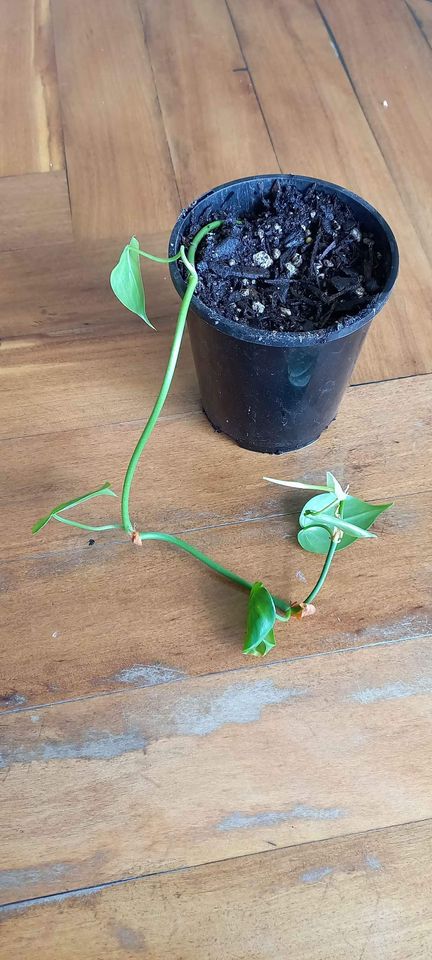The Philodendron Cordatum is an eye-catching and super easy to take care of. This indoor plant is rich green, with sturdy yet fragile leaves that breathe life into any room. In this guide, we’re gonna cover everything you need to know about taking care of a Philodendron cordatum. You’ll find out how much water and sunlight it needs, the best temperature, and loads more handy tips to help your plant thrive. Let’s get started!
What is Philodendron cordatum?
The Philodendron cordatum is a pretty unique and rare houseplant, and it’s a hot item for any home. It’s originally from Brazil, specifically from the Southeastern coast near Rio de Janeiro and São Paulo. It’s a type of plant that usually grows on the sides of trees or around rocks. You might not see this species a lot as a houseplant, but some stores do sell them. nfortunately due to its toxicity, it is very rarely chosen as a houseplant. (Source: https://en.wikipedia.org/wiki/Philodendron_cordatum)

Philodendron cordatum care overview
| Botanical Name | Philodendron Cordatum |
| Common Name | Sweetheart plant, Sweetheart vine, Heart-Leaf Philodendron |
| Family | Araceae |
| Genus | Philodendron |
| Mature Size | 1-3 ft. wide, 3-13 ft. long |
| Soil Type | Well-drained |
| Soil pH | 5.5 to 6.5 (acidic) |
| Native Area | Southeastern coastal Brazil |
| Temperature | 65 to 75°F |
| Light | Bright, indirect light |
| Watering | Moderate |
| Humidity | 60-80% |
| Fertilizer | Organic Fertilizers |
| Propagation | Stem cuttings |
| Toxicity | Toxic to humans and toxic to pets when ingested |
Caring for an philodendron cordatum
The Philodendron cordatum is a top pick for an indoor plant. Its heart-shaped leaves and trailing vines make it a total head-turner for any home or office. Looking after your Philodendron cordatum can be straightforward and fun, as long as you stick to these steps:
Light Requirements
The Philodendron cordatum is a tropical plant that’s all about bright, indirect light. Here are a few pointers on getting the lighting just right:
- Bright, indirect light: Philodendron cordatum needs a lot of light, but not directly. Direct sunlight can burn its leaves, so you’re better off putting the plant near a bright window that gets filtered sunlight or in a shady outdoor spot.
- Partial shade: The Philodendron cordatum is also cool with partial shade, especially during those scorching summer months when direct sunlight can be too much.
- North-facing window: A window facing north can be the perfect spot for a Philodendron cordatum, as it gives bright, indirect light without the direct sun.
- Observe the leaves: If your plant’s leaves start to go brown or yellow, it could mean the plant is getting too much direct sunlight. Move the plant to a shadier spot and observe the changes.
- Rotate the plant: Make sure all parts of the plant get enough light by turning it around every few weeks.
Remember, the amount of light your Philodendron cordatum needs can change depending on the light in your home, so keep an eye on it and adjust as necessary. With the right light, your Philodendron cordatum will grow healthy and lively.

Soil
Philodendron cordatum loves soil that drains well but can hold onto water long enough for the roots to drink it up. The following tips will help you pick the best soil for your Philodendron cordatum:
- Soil that drains well: The Philodendron cordatum needs soil that drains well to keep water from pooling around its roots.
- Retention of moisture: The soil should be able to hold onto water long enough for the plant’s roots to soak it up. You can boost moisture retention by adding organic stuff to the soil, like compost or peat moss.
- Avoid compacted or too densely dense heavy soils because they can block proper drainage and cause root rot.
- Potting soil: You can use a high-quality potting soil made specifically for indoor plants. For the best drainage and moisture absorption, go for a mix that includes peat moss, perlite, and vermiculite.
- The pH of the soil should be between 5.5 and 7.0 and slightly acidic to neutral. You can use a soil pH testing kit to find out the pH level of your soil.
Remember to repot your Philodendron cordatum every one to two years to freshen up the soil and stop the roots from getting too cramped. With the right soil, your Philodendron cordatum will grow strong and healthy.
Watering
Watering the Cordatum philodendron needs a good amount of water to make sure all of its roots get hydrated. It is best to water the soil until it is saturated, but make sure to drain out any water that has collected in the bottom tray. Tap water works fine for this guy, but rainwater is the best if you can get it.

Don’t forget to water this plant regularly and don’t let the soil dry out all the way between waterings. If you see your Cordatum’s leaves wilting or drooping, it’s probably under-watered and needs water right away. But remember, too much water can be a problem too, so make sure it drains well and only water it when necessary.
Temperature
Philodendron cordatum thrives in a warm and humid spots, with temperatures between 65°F and 80°F (18°C – 27°C). Try to keep the temperature steady and don’t expose the plant to any crazy temperature swings, especially anything below 60°F (15°C) or above 90°F (32°C).
Along with keeping the right temperature, watch out for cold drafts or sudden temperature changes, which can stress out the plant and hurt the leaves. If needed, you can use a heater or a humidifier to keep the ideal temperature and humidity for the plant.
Remember, every plant is unique and might need different temperatures based on where it’s growing and the conditions. It’s a good idea to keep an eye on your Philodendron cordatum’s growth and watch for any signs of stress or damage, and change the temperature as needed.
Humidity
Humidity matters a lot for the Philodendron cordatum, as these plants need higher humidity than normal. You can use a humidifier to up the humidity in a room, but that can get expensive if you’re running it all the time. Instead, try spraying the plant with water every morning to keep it healthy and happy. If that’s not an option, you can also put a tray of pebbles near the plant to help increase the humidity around it.
Fertilizer
Fertilizing regularly can really help a Philodendron cordatum during the growing season, which is usually from early spring to late summer. Here are some tips on how to fertilize your Philodendron cordatum:
- Look for a balanced fertilizer that has equal amounts of nitrogen, phosphorus, and potassium. (like a 10-10-10). It’ll give the plant the key nutrients it needs to grow well.
- Philodendron cordatums can be sensitive to too much fertilizer, so cut the amount to half of what’s recommended. During the growing season, give it some fertilizer every two to four weeks.
- Try organic fertilizers: You can also use organic fertilizers, which give the plant a slow-release supply of nutrients, like compost or worm castings.
- Fertilize your Philodendron cordatum early in the day, when the plant is actively growing and ready to take in the nutrients.
- Winter isn’t a good time to fertilize because the Philodendron cordatum goes dormant. It’s better to wait until spring to fertilize.
When you’re fertilizing your Philodendron cordatum, make sure to follow the directions and be careful not to overdo it, which can burn the roots and hurt the plant. With the right fertilization, your Philodendron cordatum will grow strong and healthy.”
Repotting
Your Philodendron cordatum will really appreciate it if you change its pot now and then, giving it fresh soil and more room for its roots to stretch out. Here’s how to do it:
- Find the right pot: Just get a pot that’s a size up from the one it’s currently in. Make sure it has holes at the bottom so water doesn’t get stuck in the soil.
- Pick the right soil: Go for a potting mix that lets water pass through easily but keeps enough moisture for the plant’s roots.
- Water the plant before the move: Give your Philodendron cordatum some water a day or two before repotting so that the soil and roots are nice and moist.
- Carefully get the plant out of its pot: Be gentle when you’re loosening the soil and taking the plant out, you don’t want to hurt the roots.
- Check the roots: Look for any damaged or rotting roots and snip them off with clean, sharp scissors.
- Time to repot: Put the plant in its new pot and fill it with fresh soil, pressing it gently around the roots to get rid of any air pockets. Then, give the plant a good watering.
- Find a good spot: Look for a bright spot without direct sunlight or chilly drafts.
Try to repot your Philodendron cordatum every 1-2 years or when it starts getting too big for its pot. The best time to do this is in spring or early summer when the plant’s got its growth spurt going on. Do it right, and your plant will be really happy and healthy.

Pruning
Giving your Philodendron cordatum a trim now and then is really important. It helps keep the plant in shape, encourages new growth, and stops it from getting too long and leggy. Here’s how to do it:
- Remove dead or yellowing leaves: Take off any leaves that are dead, turning yellow, or damaged. This makes room for new leaves and keeps diseases at bay.
- Trim leggy stems: If your plant’s getting too long, just trim the stems back to make it bushier. Always cut above a leaf node to get new growth.
- Cut back overgrown vines: If the vines are getting too long, cut them back to the length you want. Again, make sure to cut above a leaf node for new growth.
- Use clean and sharp tools: Always use clean, sharp scissors to avoid hurting the plant or spreading diseases.
- Prune in spring or summer: It’s best to prune in spring or summer when the plant’s growing. Avoid pruning in fall or winter, as it can slow the plant down and make it more likely to get damaged.
Remember to only take off up to a third of the leaves at a time so you don’t stress the plant out. If you do it right and at the right time, your Philodendron cordatum will stay bright and lively for years.
Related: Philodendron melanochrysum Care And Grow: The Ultimate Guide
Philodendron cordatum Propagation
Cutting stems with the internode and leaves intact is an easy way to propagate philodendron cordatum.
- First, find a healthy stem you’d like to make a cutting from and snip it off just below a node. Try to cut at a 45-degree angle if you can.
- After that, take off the lower leaves and dip the cut end in some rooting hormone to help it grow roots faster.
- Next, either pot your new cutting or put it in a jar of water and wait for the roots to grow. Change the water every few days and keep it in bright, indirect light.
- Once you see roots starting to form, it’s time to plant your new Philodendron cordatum! Get it in some well-draining soil, keep it watered, and find a nice bright spot for it.

Philodendron cordatum Common Pests & Plant Diseases
So, pests that often bug Philodendron cordatum are mealybugs, aphids, and spider mites. To keep these little invaders in check, regularly check your plant for stuff like webbing or white spots on the leaves. If you see them, wash the leaves and stems with soapy water or try an insecticide.
On the disease front, your Philodendron cordatum can catch usual fungal stuff like root and stem rot, leaf spot, and powdery mildew. To keep your plant healthy, make sure to water only the soil and keep the leaves dry. If it catches a disease, cut off the sick parts and treat the rest of the plant with a fungicide. Plus, avoid overwatering or planting in soggy soil to keep away from fungal problems.
By keeping an eye on your plant, giving it enough light and water, and making sure the soil drains well, you can keep your Philodendron cordatum safe from most pests and diseases. Also, insecticides and fungicides can help treat any critters or fungal issues that pop up.
Cordatum Philodendron Care Common Problems
Cordatum Philodendron is a pretty easy houseplant to look after. But, sometimes things can go wrong. Here’s some common stuff to watch out for:
- Brown or yellow leaves – Could be from too much or too little water. Check if you’re watering your plant enough and tweak it if needed.
- Drooping leaves – Another sign of watering issues. Check how moist the soil is and adjust.
- Leaves with spots – Might mean disease or bugs, so check it out and figure out what’s wrong before you do anything.
- Slow growth – If your Cordatum Philodendron isn’t growing fast enough, it might not be getting enough light. Try moving it somewhere brighter or add more light.

FAQ about Philodendron melanochrysum care
Are melanochrysum hard to care for?
No, melanochrysum are pretty easy-going. They love bright, indirect sunlight and like their soil a bit moist but not soggy. Also, feed them with a balanced fertilizer during the growing season. Make sure they have good drainage so their roots don’t get waterlogged. Lastly, give them a trim now and then to keep them looking good. If you take care of them, melanochrysum can really spruce up your home or office.
How do you get big leaves in melanochrysum?
To get bigger leaves in melanochrysum, give them lots of bright, indirect sunlight and keep the soil a little bit moist. Feeding them with a balanced fertilizer every 6-8 weeks during the growing season can also help. Lastly, regular pruning can keep the plant in good shape and looking great.
Should I mist my melanochrysum?
You don’t have to mist your melanochrysum, but some people like to because it makes the leaves look bright and fresh. If you decide to mist, don’t overdo it because too much moisture can cause fungal diseases.
Is Philodendron melanochrysum a climber?
Yes, Philodendron melanochrysum is a climber. It naturally grows long vines that can climb around stuff or up walls. If you want a climbing philodendron for your place, this one’s a great pick.
After going through all this info on Philodendron cordatum care and growth, it’s clear that with the right care, this awesome houseplant can really liven up any room. And finally, for more about monstera care please visit Famiplants – we’ll be waiting there with lots of interesting tips & tricks for every plant lover!

